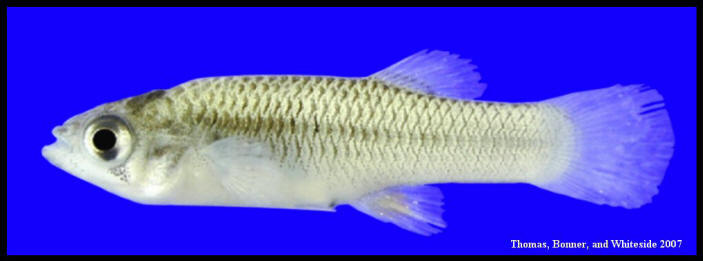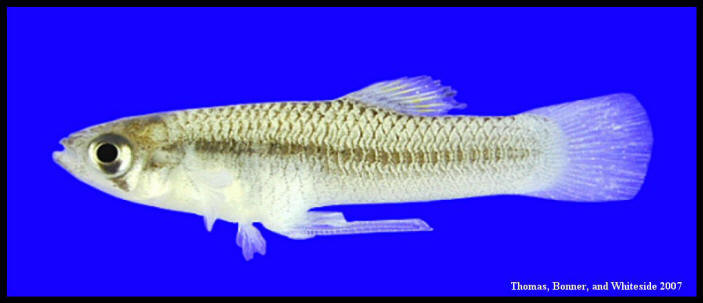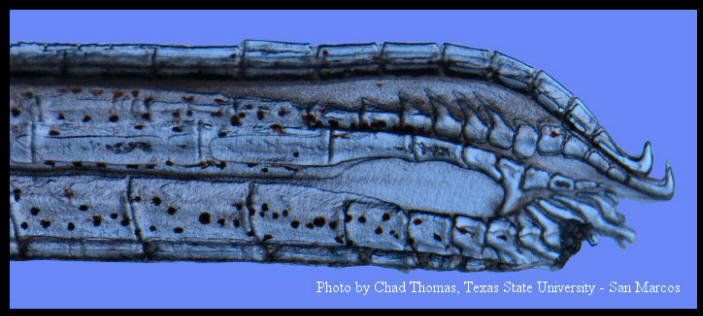|
|
||
|
Gambusia gaigei Big Bend gambusia
THIS ACCOUNT IS IN PROCESS. PLEASE CHECK BACK LATER FOR ADDITIONAL INFORMATION.
Type Locality A marshy cattail slough fed by springs, located close to the Rio Grande at Boquillas Spring, Brewster County, Texas (Hubbs 1929).
Etymology/Derivation of Scientific Name
Synonymy
Characters Maximum size: 54 mm TL (Page and Burr 1991).
Coloration: Suborbital bar weak; chin bar faint; few crescentric lateral marks; predorsal streak weak to absent; dark markings on anus of mature females; lateral stripe broad; caudal fin without prominent dark markings; markings on side crescentric; dorsal and (in females) anal fins with yellow pigmentation (lost in preservation); dusky lateral stripe pronounced; mouth with dark markings or anal spot of females restricted to area immediately around anus; predorsal stripe thin or absent; no dark bands on sides; median fins without black spots near their bases (Hubbs et al. 2008).
Counts: Dorsal fin rays 7-8 (Hubbs et al. 2008).
Body shape: Body deep, maximum body depth goes into standard length about 4 times in females; dorsal fin origin well behind anal fin origin (Hubbs et al. 2008).
External morphology: Longest serra goes 1.2 times (usually ranges from 1.0-1.4) into width of segment on ray 4p of gonopodium; elbow of gonopodium composed of usually 2 (rarely 3) fused segments; tip of anterior branch of 4th ray of male gonopodium does not extend to tip of posterior branch; pectoral fin of males with slight indentation, shallower than widest pectoral fin ray; distal segments of anterior branch of 4th fin ray of gonopodium not coalesced to elbow; spines at tip of 3rd anal fin ray of male gonopodium 4-10 times longer than wide (Hubbs et al. 2008).
Internal morphology: Intestinal canal short with few convolutions (Hubbs et al. 2008).
Distribution (Native and Introduced) U.S. distribution: Restricted to an extremely limited series of springs in the Boquillas Crossing and Rio Grande Village areas of Big Bend National Park (Hubbs et al. 2008).
Texas distribution: Endemic to Boquillas Spring and Graham Ranch Warm Springs (ca. 1.6 km southwest of Boquillas Spring), Brewster Co., TX (Hubbs and Springer 1957; Guillory 1980). Total population reduced to only three individuals in 1957, with the population at the type locality extirpated (Guillory 1980). Later introduced into Croton Springs on Graham Rance, and Willow Tank (ca. 66 km west of type locality; Hubbs and Brodrick 1963; Guillory 1980). Restricted to an extremely limited series of springs in Big Bend National Park (Hubbs et al. 2008).
Abundance/Conservation status (Federal, State, NGO) State Endangered (Texas); Federally Endangered (Hubbs et al. 2008). Listed as Endangered by the American Fisheries Society; categories of threats: present or threatened destruction, modification, or reduction of habitat or range; other natural or anthropogenic factors that affect the existence of this species, including impacts of nonidigenous organisms, hybridization, competition, and/or predation; and a narrowly restricted range (Jelks et al. 2008). Two populations believed to have originally existed; one at Boquillas Spring and the other at “Spring 4” east of the Rio Grande Village campground in the national park; however, the former population is now extinct and the latter was once extirpated (Hubbs et al. 2008). The species now consists of descendents of three individuals of the “Spring 4” population and is maintained in refuges in Big Bend National Park and at the U.S. National Fish Hatchery in Dexter, New Mexico as well as Spring 4 (Hubbs et al. 2008).
Habitat Associations Macrohabitat:
Mesohabitat:
Biology Spawning season:
Spawning habitat:
Spawning behavior:
Fecundity:
Age at maturation:
Migration:
Growth and Population structure:
Longevity:
Food habits:
Phylogeny and morphologically similar fishes
Host Records
Commercial or Environmental Importance
References Guillory, V. 1980. Gambusia gaigei (Hubbs), Big Bend gambusia. pp. 540 in D. S. Lee et al., Atlas of North American Freshwater Fishes. N. C. State Mus. Nat. Hist., Raleigh, i-r+854 pp.
Hubbs, C. and H.J. Brodrick. 1963. Current abundance of Gambusia gaigei, an endangered fish species. Southwestern Naturalist 8(1):46-48.
Hubbs, C., R.J. Edwards, and G.P. Garrett. 2008. An annotated checklist of the freshwater fishes of Texas, with keys to identification of species. Texas Journal of Science, Supplement, 2nd edition 43(4):1-87.
Hubbs, C.L. 1929. Studies of the fishes of the order Cyprinodontes. VIII. Gambusia gaigei, a new species from the Rio Grande. Occas. Pap. Mus. Zool. Univ. Mich. 198:1-11.
Hubbs, C., and V.G. Springer 1957. A revision of the Gambusia nobilis species group, with descriptions of three new species, and notes on their variation, ecology and evolution. Texas Journal of Science 9(3):279-327. Jelks, H.L., S.J. Walsh, N.M. Burkhead, S. Contreras-Balderas, E. Diaz-Pardo, D.A. Hendrickson, J. Lyons, N.E. Mandrak, F. McCormick, J.S. Nelson, S.P. Platania, B.A. Porter, C.B. Renaud, J.J. Schmitter-Soto, E.B. Taylor, and M.L. Warren, Jr. 2008. Conservation status of imperiled North American freshwater and diadromous fishes. Fisheries 33(8):372-407.
Page, L. M. & B. M. Burr. 1991. A field guide to freshwater fishes of North America north of Mexico. Houghton Mifflin Company, Boston, Massachusetts. 432 pp. Peden, A.E. 1973. Variation in anal spot expression of Gambusiin females and its effect on male courtship. Copeia 1973(2):250-263. Warburton, B.E. 1958. Selection studies on artificial populations of Gambusia. M.A. Thesis, University of Texas, Austin, Texas. |
||
|
|
||


